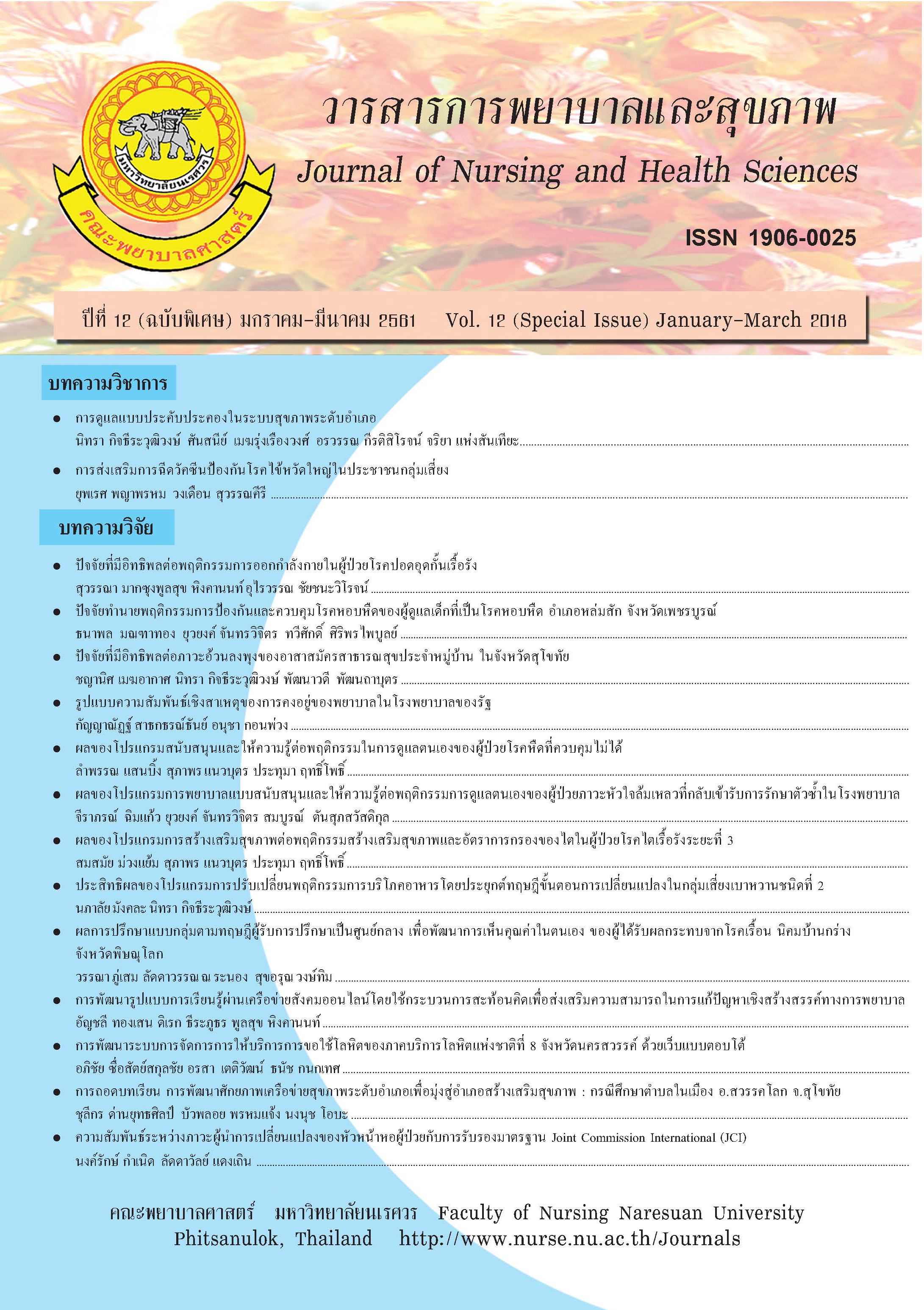ปัจจัยทำนายพฤติกรรมการป้องกันและควบคุมโรคหอบหืดของผู้ดูแลเด็ก ที่เป็นโรคหอบหืด อำเภอหล่มสัก จังหวัดเพชรบูรณ์
Main Article Content
บทคัดย่อ
การวิจัยเชิงพรรณนาครั้งนี้ มีวัตถุประสงค์เพื่อศึกษา 1) ปัจจัยนำ ปัจจัยเสริม ปัจจัยเอื้ออำนวย 2) พฤติกรรมการป้องกันและควบคุมโรคหอบหืด และ 3) ปัจจัยทำนายพฤติกรรมการป้องกันและควบคุม โรคหอบหืดของผูดู้แลเด็กที่เปน็ โรคหอบหืด กลุม่ ตัวอยา่ งเปน็ ผูแ้ ลเด็กที่เปน็ โรคหอบหืด อายุ 1 วัน-6 ปี โดยดูแลเด็กอย่างน้อย วันละ 8 ชั่วโมง ที่มารับการรักษาที่คลินิกโรคหืดเด็ก กลุ่มงานพยาบาลผู้ป่วยนอก โรงพยาบาลหล่มสัก อำเภอหล่มสัก จังหวัดเพชรบูรณ์ จำนวน 130 คน คัดเลือกกลุ่มตัวอย่างแบบเฉพาะ เจาะจง เครื่องมือที่ใช้ในการวิจัย คือ แบบสอบถามข้อมูลทั่วไปของผู้ดูแลและเด็กที่เป็นโรคหอบหืด ปัจจัย นำ ปัจจัยเสริม ปัจจัยเอื้ออำนวย โดยประยุกต์ใช้แนวคิด PRECEDE Framework ของกรีนและกรูเตอร์ (Green and Kreuter) และพฤติกรรมการป้องกันและควบคุมโรคหอบหืด ผ่านการตรวจสอบความตรง เชิงเนื้อหาจากผู้ทรงคุณวุฒิ 5 ท่าน ค่าดัชนีความสอดคล้องของเนื้อหาเท่ากับ 0.87 ค่าความเชื่อมั่นในส่วนของ ความรู้ ใช้สูตร KR 21 เท่ากับ 0.80 ค่าความเชื่อมั่นใช้สัมประสิทธิ์แอลฟาของครอนบราค เท่ากับ 0.92 และ วิเคราะห์ข้อมูลโดยใช้สถิติเชิงพรรณนา และวิเคราะห์การถดถอยเชิงพหุคูณ(Multiple Linear Regression) แบบ Stepwise regression analysis ผลการวิจัยพบว่า 1. ปัจจัยนำด้านความรู้ ด้านทัศนคติ ปัจจัยเสริมด้านบุคลากรทางสาธารณสุข ปัจจัยเอื้ออำนวยด้าน แหล่งทรัพยากรและด้านการเข้าถึงทรัพยากรหรือการเข้าถึงบริการอยู่ในระดับสูง ร้อยละ 100.0, 86.9, 91.5, 76.2 และ 78.5 ตามลำดับ 2. ผู้ดูแลเด็กมีพฤติกรรมการป้องกันและควบคุมโรคหอบหืดอยู่ในระดับสูง ร้อยละ 53.1 3. ปัจจัยเอื้ออำนวยด้านแหล่งทรัพยากรสามารถทำนายพฤติกรรมการป้องกันและควบคุมโรคหอบหืด ของผู้ดูแลเด็กได้ในระดับสูง ร้อยละ 76.2 (R2 = 0.094, p < 0.001)
Article Details
เอกสารอ้างอิง
คุณภาพชีวิตผู้ป่วยโรคปอดอุดกั้นเรื้อรัง. วารสาร
การพยาบาลและสุขภาพ, 6(2), 12-24.
คณะกรรมการปรับปรุงแนวทางการวินิจฉัยและรักษา
โรคหืด. (2551). แนวทางการวินิจฉัยและรักษา
โรคหืดในประเทศไทย สำหรับผู้ป่วยเด็ก พ.ศ.
2551. ม.ป.ท.
จุฬาลักษณ์ แก้วสุก. (2559). ปัจจัยทำนายพฤติกรรม
ของมารดาในการป้องกันโรคติดเชื้อเฉียบพลัน
ระบบหายใจในเด็กวัยก่อนเรียน. วารสาร
คณะพยาบาลศาสตร์ มหาวิทยาลัยบูรพา,24
(4),54-64
ปิยนุช ริยาพันธ์. (2553). ปัจจัยที่มีความสัมพันธ์กับ
พฤติกรรมการของมารดาในการดูแลบุตรที่ป่วย
ด้วยโรคหอบหืด คณะแพทยศาสตร์ โรงพยาบาล
รามาธิบดี มหาวิทยาลัยมหิดล (วิทยานิพนธ์
วิทยาศาสตรมหาบัณฑิต สาขาสุขศึกษา).
กรุงเทพฯ: บัณฑิตวิทยาลัย มหาวิทยาลัย
เกษตรศาสตร์.
โรงพยาบาลหล่มสัก. (2557). รายงานสถิติผู้ป่วยตาม
สาเหตุการป่วย. เพชรบูรณ์: กลุ่มงานแผน
ยุทธศาสตร์ โรงพยาบาลหล่มสัก.
โรงพยาบาลหล่มสัก. (2558). รายงานสถิติผู้ป่วยคลินิก
โรคหืดประจำปี พ.ศ.2558. เพชรบูรณ์: คลินิก
โรคหืด โรงพยาบาลหล่มสัก.
วัชรา บุญสวัสดิ์. (2554). การพัฒนาระบบการดูแล
โรคหืด เครือข่ายหน่วยบริการปฐมภูมิ ระดับ
อำเภอและโรงพยาบาลส่งเสริมสุขภาพตำบล.
กรุงเทพฯ: บูเลติน.
สมาคมโรคภูมิแพ้ โรคหืด และวิทยาภูมิคุ้มกันแห่ง
ประเทศไทย. (2554). ความรู้เรื่องโรคหืด
สำหรับประชาชน. สืบค้น 10 สิงหาคม 2557,
จาก http://allergyexpert.org/main.php.name=
article&file=readmore&cate_id=&id=44
สมาคมสภาองค์กรโรคหืดแห่งประเทศไทย. (2559).
แนวทางการวินิจฉัยและรักษาโรคหืดใน
ประเทศไทย สำหรับผู้ใหญ่และเด็ก สืบค้น 10
ตุลาคม 2559, จาก http://www.tac.or.th/?
tag=asthma- guideline-thailand
สุกัญญา สร้างนอก. (2543). ปัจจัยที่มีอิทธิพลต่อ
พฤติกรรมของมารดาในการดูแลบุตรวัย
ก่อนเรียนที่ป่วยเป็นโรคหอบหืด (วิทยานิพนธ์
พยาบาลมหาบัณฑิตสาขาการพยาบาลแม่และ
เด็ก). กรุงเทพฯ: คณะแพทยศาสตร์โรงพยาบาล
รามาธิบดี มหาวิทยาลัยมหิดล.
สุพัตรา สารพัดนึก. (2544). ประสิทธิผลของโปรแกรม
สุขศึกษาเพื่อส่งเสริมพฤติกรรมการดูแลบุตร
ของมารดาที่มีบุตรป่วยด้วยโรคหอบหืด อายุ
แรกเกิด-5 ปี โรงพยาบาลปทุมธานี จังหวัด
ปทุมธานี (วิทยานิพนธ์วิทยาศาสตรมหาบัณฑิต
สาขาสุขศึกษา). กรุงเทพฯ: บัณฑิตวิทยาลัย
มหาวิทยาลัยเกษตรศาสตร์.
สำนักงานหลักประกันสุขภาพแห่งชาติ. (2552).
โครงการพัฒนาระบบการใหบ้ ริการผูป้ ว่ ยโรคหืด
ตามรูปแบบโปรแกรม Easy Asthma Clinic
สำหรับหน่วยบริการในระบบหลักประกันสุขภาพ
แห่งชาติ. กรุงเทพ ฯ: สำนักหลักประกันสุขภาพ
แห่งชาติ.
สำนักงานสารนิเทศและประชาสัมพันธ์กระทรวง
สาธารณสุข. (2551). วัณรณรงค์โรคหอบหืดโลก
2551 ภายใต้การสนับสนุนของสมาพันธ์โรค
หืดองค์การอนามัยโลก. สืบค้น 10 พฤษภาคม
2558, จาก http://www.moph.go.th /ops/ipng/
page/search-neqs.php
สำนักนโยบายและยุทธศาสตร์ กระทรวงสาธารณสุข.
(2557). สถิติสาธารณสุข.กรุงเทพฯ: องค์การ
สงเคราะห์ทหารผ่านศึก.
อาภาวรรณ หนูคง, สุดาภรณ์ พยัคฆเรือง, ยุวดี พงษ์สาระ
นันทกุล, และศิริวรรณ จูฑะพงษ์. (2550).
การจัดการของผู้ดูแลในการดูแลเด็กโรคหืด.
วารสารพยาบาลศาสตร์, 20(1), 50-58.
Boehmer, A.L.M., & Merkus, P.J.F.M. (2006). Asthma
therapy for children under 5 year of age.
Retrieved May 15, 2015, from http://
www.researchgate.net/publication/ 7411872
_Asthma_ therapy_for_children_ under_
5_years_of_age/links/02e7e52e139ad
64705000000
Global Initiative for Asthma. (2011). Pocket guild
for Asthma management and prevention.
Retrieved December 8, 2015, from http://
www.ginasthma.org/uploads/ users/ files/
GINA_PocketGuide_2011.pdf
Green, L. W., & Kreuter, M. W. (2005). Health
Program Planning an Educational and
Ecological approach (4th ed.). New York:
McGraw.
National Institute of Environmental Health Science.
(2009). National Institutes of Health. Retrieved
July 10, 2015, from http://www.niehs.nih.gov/
health/topics/agents/syabpa/
Word Health Organization. (2005). Chronic respiratory
disease. Retrieved July 8, 2015, from http://
who.int/respiratory/asthma/en/
Word Health Organization. (2009). Global surveillance
prevention and control of Chronic respiratory
diseases: A comprehensive approach.
Retrieved May 8, 2015, from http://who.int/grad/
publications/ GARD_Manual/en/index.html


